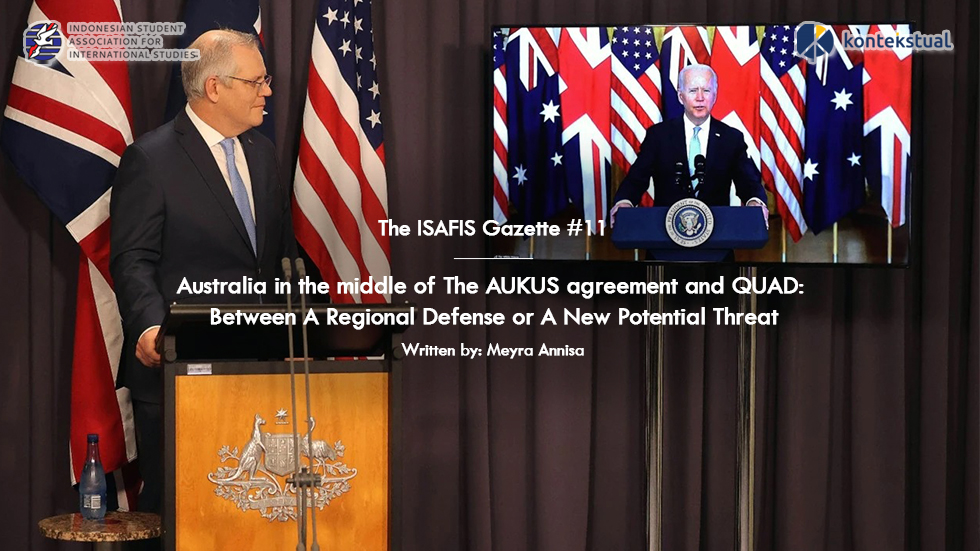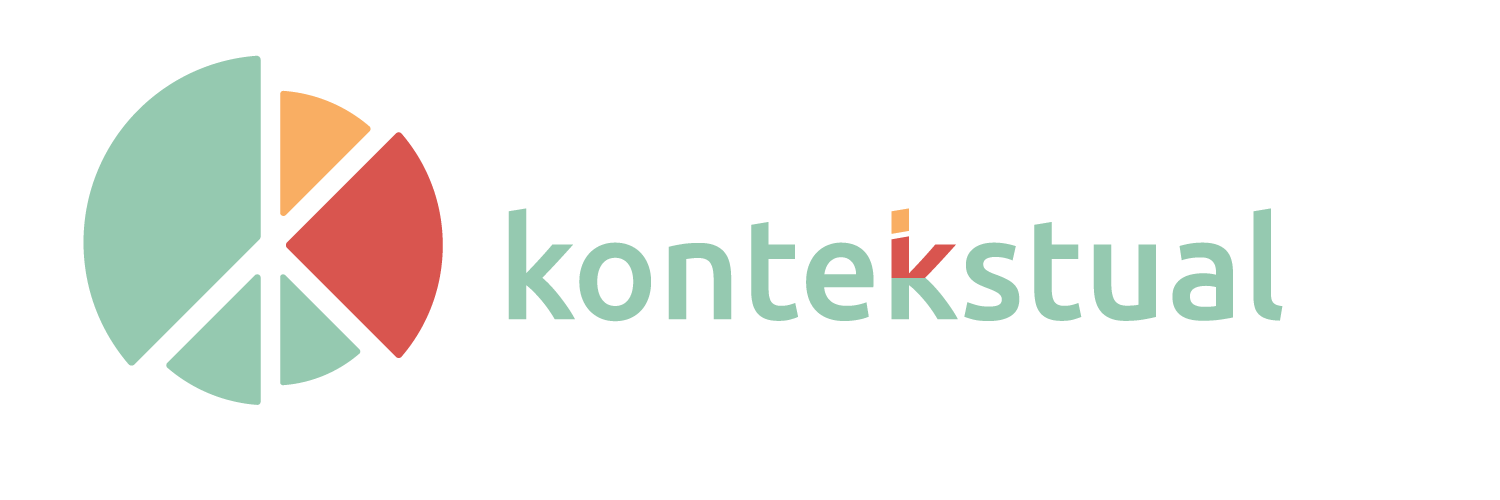Australia in The Middle of The AUKUS Agreement and QUAD: Between A Regional Defense or A New Potential Threat

Illustration from ISAFIS
This article is originally published on ISAFIS’ Medium. Click here to be redirected.
Australia is now bound by the QUAD and the AUKUS Agreement, both of which have an interest in rivaling China’s existence. QUAD consists of four countries namely, Australia, Japan, India, and the US—a bloc built in defending the Indo-Pacific geopolitical area. The formation of QUAD itself can be traced back to the baleful tsunami in 2004. The four countries became active in delivering humanitarian aid and worked together as a group initiated by The United States’ Integrated Relief Operation to help countries affected by the 2004 tsunami that hit the Indian Ocean region. These four countries coordinated and obtained the nickname “The Tsunami Core Group” which encouraged them to cooperate more intensely and more strongly.
QUAD itself consists of two chapters, with the first one beginning in 2007 and aiming to build a security strategy between the four countries and also the Asia-Pacific region, specifically in the field of maritime security and defense cooperation. The Japanese Prime Minister at the time, Shinzo Abe, also expressed his hope for the QUAD to increase defense cooperation, especially with India in the Indo-Pacific region (a region that is free, prosperous, and dynamic). QUAD I was scheduled to hold joint military exercises that were finally first held in the Bay of Bengal in 2007. Aside from that, QUAD I aimed to strengthen the cooperation of the four countries in competing with China which, at that time, had begun to rise.
However, QUAD I ended in obscurity because Australia suddenly began to cooperate with China. Even the Prime Minister of Australia at the time, Brendan Nelson, stated during his visit to China that QUAD was not Australia’s main destination. Nelson’s blatant statement spurred various vague assumptions regarding QUAD I’s fate that it was eventually declared a failure. Australia itself was considered capricious because, during Nelson’s visit to India, the Australian side implied that it wanted to cooperate again through the QUAD. Yet, after the statement, Australia did the entire opposite by re-establishing cooperation with China.
After a decade without clarity about QUAD I, finally in 2017, QUAD II was formed as the replacement for QUAD I. QUAD II is prompted as a response to China’s increasing power, a threat that several countries deem capable of disrupting the international system that has been in force (such as in military, political, and economic activities). In QUAD II, the US became dominant because Washington considered QUAD II as one of the main US avenues to ensure American security and interests from China by expanding allied relations with the Indo-Pacific region. QUAD II’s reorganization in 2017 aimed to realize a free and more open Indo-Pacific region. The formation of QUAD II was mainly due to the four QUAD II member countries’ concern about China’s economic movements as well as its military power that could push China’s main capital to become a new world power, proven by how the United States is also one of the member countries that approved the reorganization of QUAD II.
On September 15, 2021, Australia further strengthened its defense through AUKUS along with the US and the UK. AUKUS was surprisingly considered as the trigger for the collapse of QUAD 2 because Australia decided to cooperate with America, leaving India and Japan in confusion. The pact shares similar interests as QUAD, namely in defending the Indo-Pacific region and the South China Sea. The existence of the AUKUS Pact has given rise to serious polemics among the countries involved. On the other side, Australia also had tensions with France. As we know, Washington showcases support to Australia through AUKUS in the form of nuclear-powered submarines which will be sent to guard the Indo-Pacific territory. In return, Australia has canceled its agreement with France regarding twelve diesel-powered submarines, choosing to side with the US via AUKUS and potentially disrupting Australia’s cooperation with the European Union in the field of trade and political economy. The US is also considered to have been taking advantage of Australia as it is one of the countries in the vicinity of the Indo-Pacific region. Thus, the US has been facilitating Australia with long-range missiles. This particular decision drove China to be more vigilant because China is considered unable to equalize its security technology to what America gives to Australia. The nuclear submarine is also considered to last 30 years.
The AUKUS polemic does not stop there. With the existence of AUKUS, Australia is regarded to receive excessive special treatment from the White House, as seen from the previous cooperation established through QUAD. Meanwhile, India and Japan were not granted the same treatments as Australia. Due to its proximity to the Asian region, Australia is also considered to be utilized by the US to expand its military bases as the US is quite weak in terms of alliance within the Southern Hemisphere region. The existence of AUKUS could also potentially be the cause of a forthcoming Cold War among several countries, including countries in the Indo-Pacific region that consider Australia to have violated the nuclear non-proliferation commitments.
Australia’s overall defense stance needs to be questioned. By agreeing to cooperate with the AUKUS Pact on its involvement in nuclear power defense, and contrary to Australia’s commitment to nuclear non-proliferation, several countries have begun to question and regret Australia’s stance. Australia’s position between the two polemics, QUAD and AUKUS, of the same interests as different allied countries raises the question, will this Australian attitude be a regional defense solution or trigger another crisis among nations?
References
Galih, B. (2021, September 22). Soal Kapal Selam Nuklir Australia, Menlu Ri Sebut sekjen PBB Ingatkan potensi Perang Dingin. Retrieved October 01, 2021, from KOMPAS.com: https://nasional.kompas.com/read/2021/09/22/09325341/soal-kapal-selam-nuklir-australia-menlu-ri-sebut-sekjen-pbb-ingatkan-potensi?page=all
Government, Australian. (2021,). Quad. Retrieved October 01, 2021, from Australian Government Department of Foreign Affairs and Trade: https://www.dfat.gov.au/international-relations/regional-architecture/quad
Kaushik, K. (2021, September 18). Explained: The AUKUS agreement to equip Australia with N-subs, and why it has upset France. Retrieved October 01, 2021, from The Indian Express: https://indianexpress.com/article/explained/aukus-agreement-to-equip-australia-with-nuclear-submarines-7513013/
Mata Mata Politik. (2021, September 22). APA ITU Aukus Dan Kenapa peran Indonesia penting? Retrieved October 01, 2021, from Mata Mata Politik: https://www.matamatapolitik.com/belajar-politik/apa-itu-aukus
Sorongan, T. P. (2021, September 24). Ada Apa Nih? as-jepang-india-australia merapat ke Washington. Retrieved October 01, 2021, from CNBC Indonesia: https://www.cnbcindonesia.com/news/20210924142050-4-278938/ada-apa-nih-as-jepang-india-australia-merapat-ke-washington
Meyra Annisa Firlani is International Relations student at National University and a staff of the Research and Development division in ISAFIS. She can be found on Instagram with the username @meyraaf





